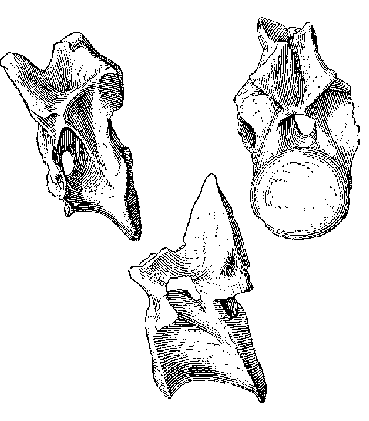







Vertebrates are members of the larger phylum Chordata, and show all of the major chordate features at some point in their life cycles: notochord, dorsal hollow nerve cord, pharyngeal slits, and a post-anal tail. But what makes a vertebrate a vertebrate? The answer isn't as simple as you might think. Let's look at a typical vertebrate feature, the vertebral column, or backbone, which surrounds and protects the main nerve cord:

These vertebrae have two main parts. (Incidentally, they are reptile vertebrae of an unidentified species, from the Triassic-age Moenkopi Formation of northern Arizona.) The centrum is the main bony disk-shaped or spool-shaped portion of the vertebra; it forms around, and usually replaces, the notochord. On the dorsal side of the centrum is the neural arch, through which the nerve cord or spinal cord passes. The neural arch is often elongated into a neural spine, which may be very long in the case of "sail-backed" synapsids such as Dimetrodon. In tetrapods and a few bony fishes, the neural arches bear processes, the zygapophyses, that link the vertebrae together.
Vertebrae differ considerably in form among different groups of vertebrates. In many vertebrates, the ventral side of the centrum bears spines, which in bony fish fuse to form the haemal arch, through which the main blood vessel passes. This arch is not present in other vertebrates, which may have lateral spines on the centrum instead of ventral spines. The jawless fish of today, the hagfish and lampreys, lack vertebral centra -- thus they are not "vertebrates" in the usual sense -- but they have neural arches on their notochords.
Probably the most important vertebrate feature is the presence of neural crest cells. In early development, as the nerve cord is forming, neural crest cells leave the nerve cord and move through the body. These cells form, or cause to form, many important nerves, neural ganglia, and many head and facial features. Other features that separate vertebrates from other chordates include: a relatively well-developed brain, paired complex eyes, a muscularized mouth and pharynx, and a well-developed circulatory system with a heart.
Vertebrates possess two types of bone. Dermal bone consists of bony structures (plates and scales) that develop in the skin. The bony armor of the earliest jawless fish was dermal bone; so are shark scales, shoulder blades, and the roof of your skull. Dermal bone does not form from cartilage first and then calcify, but endoskeletal bone does; in fact, in cartilaginous fishes it may never form true bone. Vertebrae, ribs, appendages, and the jaw are endoskeletal bone. The vertebrate skull is actually a complex structure of both endoskeletal and dermal bone.
All vertebrates have cartilage in addition to bone, or instead of bone. Cartilage may be flexible, like the cartilage in your nose and ears, or hard and firm, like the cartilage you can feel in your larynx (voicebox). Cartilage also covers the adjoining surfaces of bones in movable joints; damage or breakdown of this cartilage results in painful movement.
The calcified cartilage that makes up shark teeth and vertebrae is not true bone; it is dead when functional, whereas bone is a living tissue.


